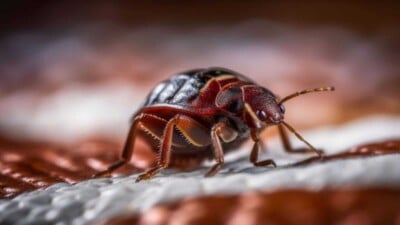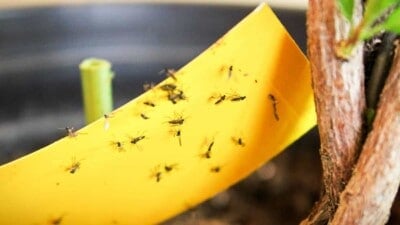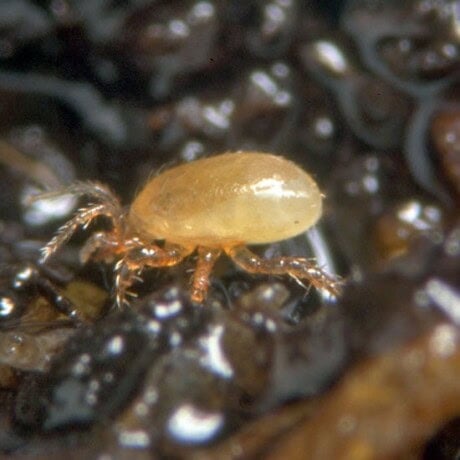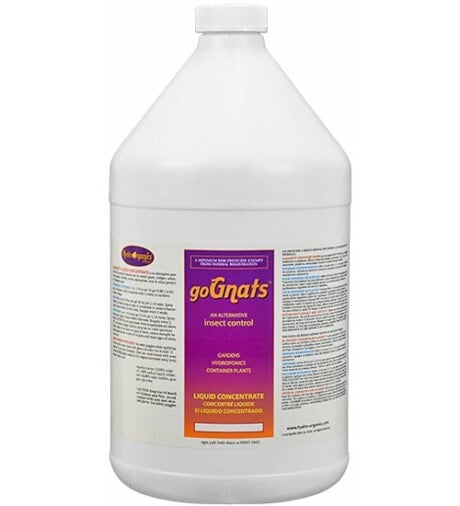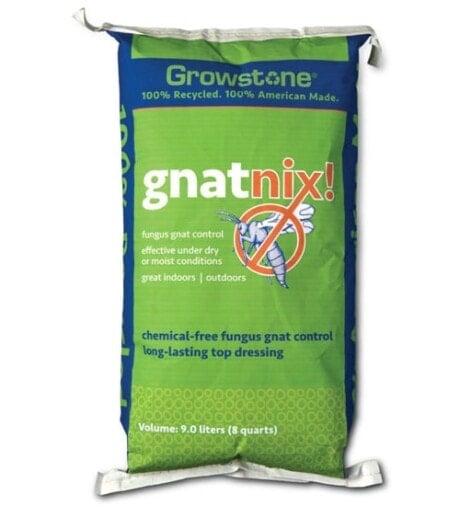How to Get Rid of Fungus Gnats Effectively (Complete Guide)

Both the larval and adult stages of fungus gnats can cause big problems for houseplants. This complete guide lays out all the ways you can get rid of fungus gnats indoors effectively.
Fungus gnats (families Mycetophilidae and Sciaridae) are a common pest of plants grown indoors, especially where humidity and moisture are high. They’re usually first noticed when the harmless adults are seen flying around house plants or gathered at a nearby window.
These non-biting adult gnats can become a flying nuisance. But it’s the larval stage, feeding in the soil, that can damage tender plant roots.
Read on to learn more about what fungus gnats are, how to identify them properly, and all the methods you can use to effectively get rid of them.
What are Fungus Gnats?
Fungus gnats are pest insects of the size of fruit flies that mainly harm indoor houseplants. Adult gnats are attracted to the moisture in potting soil and lay their eggs on organic debris matter near the soil surface.
Since they can’t bite people and can’t transmit diseases, fungus gnats are technically safe for humans to be around, but their larvae can be a problem for indoor plants.
Their larvae eat mostly fungi and other organic matter in the soil, but they also chew on roots, making them a potential pest in greenhouses, nurseries, and potted plants. Indoors, adult fungus gnats can cause problems if they find their way out of potted plants.
They can also spread pythium, which is a group of plant pathogens that causes seedlings to rot.

How to Identify Fungus Gnats
Adult fungus gnats are delicate, grayish-black, mosquito-like flies (1/8 inch long) with long legs and one pair of clear wings. They are not strong fliers and emerge from potted plants, especially when watering.
Adults have segmented antennae that are longer than their head and these help distinguish them from other more robust shore flies that are commonly found in places like greenhouses and are found near algae and decomposing organic matter since the latter have short antennae instead.
Larvae or maggots (1/4 inch) have a shiny black head and an elongated, whitish to transparent body. They are most abundant in damp, rich soils and feed on root hairs, fungi, and other organic materials.


Life Cycle of a Fungus Gnat
Adults live about one week and lay up to 300 eggs in the cracks and crevices of growing media such as rich, moist soils. They develop in four stages, namely egg, larva including four larval stages or instars, pupa, and adult.
Females lay eggs in moist organic media, and the developing larvae feed on the media before emerging as tiny, oblong pupae. At a temperature of 75 degrees Fahrenheit, it takes approximately three days for eggs to hatch.
Within 4-6 days tiny larvae emerge and begin the larvae feed on plant roots during their two-week period. The pupal stage lasts 3-4 days before the pupae turn into young adults and leave the soil and begin the next generation.
The entire life cycle from egg to adult may be completed in as little as 3-4 weeks depending on temperature. Because of their proclivity and relatively short gestation, potted plants can host each stage — egg, larvae, pupae, adult — in multiple generations at once. Because of this remedies usually require repeated applications until there are no surviving eggs.
Damage Caused by Fungus Gnats
Plant symptoms that indicate fungal gnats are seen as sudden wilting, loss of vigor, poor growth, and yellowing. With severe infestations, a considerable portion of the plants may be lost. Especially prone to injury:
- Geraniums
- African violets
- Carnations
- Poinsettias
Note: Larvae are most damaging to seedlings, cuttings, and young plants.
How to Get Rid of Fungus Gnats (Effective Fungus Gnat Control)
- Inspect plants thoroughly prior to purchase for signs of insect pests. Turn up soil carefully near the base of the plant and look for the glossy, clear larvae. Reject any plant sending up flying gnats.
- If you suspect a fungus gnat infestation, an effective way to check for fungus gnat larvae is to place potato slices into the growing medium. Larvae will start to move to the potato slices and start feeding on them within a few days. Turn them over to look for larvae on the underside.
- Fungus gnats do best in damp soils; be careful not to overwater, especially during winter months when plants use less. When potting, avoid water holding, organic material such as peat moss that may encourage egg laying.
- If pests are present, allow the soil to dry to a depth of one to two inches between waterings. This not only kills larvae and inhibits the development of eggs, but it also makes the soil less attractive to egg-laying females. Apply Gnat Nix as a top dressing to significantly reduce pest populations.
- Use Yellow Sticky Traps placed horizontally at the soil surface to capture large numbers of egg-laying adults. The gnats are attracted to yellow and are easily removed from the trap before they can lay more eggs, so go for yellow sticky cards instead of blue ones.
- You can also make a DIY trap by adding equal parts water and apple cider vinegar to a shallow container, along with a few drops of liquid dish soap. Stir it all gently and place the trap near the base of an affected plan or inside the pot on top of the soil. Make sure to check it after every few days and refresh the solution.
- Mosquito Bits, Gnatrol, and Microbe-Lift® BMC contain Bacillus thuringiensis var. israelensis (Bti), a highly selective biological pesticide that kills damaging larvae, yet is safe for fish, wildlife, humans, and non-target species. They contain no harmful residues, unlike other insecticide options on the market.
- Top dress houseplants with Beneficial Nematodes to destroy the larvae stage. Nematodes are microscopic round worms that penetrate fungus gnat larvae, as well as harmful lawn and garden grubs, fleas, and other soil-borne pests (they do not harm earthworms), then release a bacterium that consumes the pest from the inside out. The long-lasting nematodes are safe for use around pets, plants, and your family.
- AzaMax contains azadirachtin, the key insecticidal ingredient found in neem oil. Mix 1 Tbsp/ gallon of water and apply it as a soil drench for effective control of soil-borne insect larvae. With high pest pressure make applications every 5 to 6 days.
- Flying Insect Killer, a combination of peppermint, cinnamon, and sesame oils, is a non-toxic spray that will get rid of gnats and other insects that gather around windows.
Tip: The Fungus Gnat Predator (Hypoaspis aculeifer) is a tiny, but effective killer of fungus gnat and other harmful larvae found in soil. On release, they make for a slow but steady, persistent decline in pest numbers. This beneficial insect prowls the soil attacking the larvae and feeding on their contents. Release 10,000 predators per 200 – 1,000 square feet depending on pest levels.


